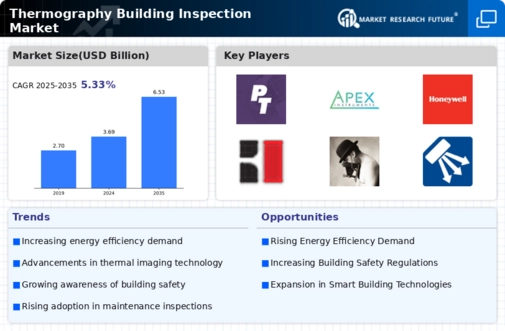The Thermography Building Inspection Market, as revealed by the market research report, is predicted to grow at a faster pace during the forecast period backed by various drivers. Such factors include growing concerns about energy efficiency in buildings expected to significantly increase the market for thermographic building inspection services. Managers and owners of structures wish to minimize energy expenses by searching for strategies to stop heat loss as well as moisture penetration and electrical faults.
The increasing focus on doing regular preventive maintenance helps the use of thermography as there is potential to avoid excess expenditure on repair of damaged structures while increasing the lifespan of systems in a building. This emerging sector is expected to be a viable one for companies operating in this one.
New devices of mobile and handheld thermographic imaging devices are changing the manner of operation, and the recent statistics suggest these are becoming more popular and more accessible to the Chimney inspector.
Technological progression in thermal imaging device, especially enhancement of image quality and incorporation of real time analysis, is making the process of inspection efficient and precise. The growing use of artificial intelligence in thermographic applications also contributes to the automatic identification of defects, thus enhancing inspection procedure reliability. Eco friendly approaches and sustainable building certifications also have market impact as clients look for strategies that complement their ecofriendly objectives.
The need for remote inspection has fostered creativity in thermographic operations as it enables assessment activities without the need for a physical presence which enhances the service options that are available to clients.
Thermography Building Inspection Market Drivers
Increasing Demand for Energy Efficiency and Sustainability
The growing emphasis on energy efficiency and sustainable building practices is a significant driver for the Thermography Building Inspection Market Industry. As governments and organizations across the globe prioritize reducing carbon footprints, there is a rising demand for energy-efficient buildings. Thermography inspections play a vital role in identifying energy loss problems, such as thermal bridging, air leakage, and inadequate insulation.
By employing thermographic analysis, building owners can pinpoint areas that require improvement and implement corrective measures that enhance energy efficiency. This trend not only leads to cost savings on utility bills but also aligns with broader environmental objectives. Furthermore, regulatory frameworks are increasingly mandating building inspection processes for energy efficiency compliance, further propelling the market's growth.
The integration of advanced thermographic technologies into standard building inspection practices is expected to redefine efficiency strategies, positioning thermography as a pivotal tool for modern building management. This overall evolution in the approach to energy consumption and sustainability will significantly contribute to the expansion and enhancement of the Thermography Building Inspection Market Industry as we move toward 2032.
Technological Advancements in Thermography Equipment
Technological advancements in thermography equipment are significantly driving the growth of the Thermography Building Inspection Market Industry. Innovations in infrared imaging technology, data analytics, and software integration are enhancing the functionality and accuracy of thermographic inspections. Newer models of thermal cameras offer higher resolution, improved sensitivity, and user-friendly interfaces, making them more accessible to inspectors and building professionals. Additionally, the integration of artificial intelligence and machine learning techniques into thermography inspection processes allows for more accurate analysis and prediction of building performance issues.
These advancements not only improve efficiency but also reduce the time and costs associated with building inspections, resulting in increased adoption of thermographic practices across various sectors.
Rising Awareness of Building Maintenance and Safety
Rising awareness regarding building maintenance and safety is driving the Thermography Building Inspection Market Industry. The necessity to ensure safe living and working environments has led building owners and managers to prioritize regular inspections. Thermography offers non-invasive methods to detect issues like moisture intrusion, electrical faults, and structural deficiencies that could jeopardize safety. This growing emphasis on proactive building maintenance is essential, especially in commercial sectors where compliance with safety regulations is mandatory. By utilizing thermographic inspections, stakeholders can not only enhance safety but also increase the lifespan of buildings, reinforcing the value of these inspections in the market.
The increasing emphasis on energy efficiency and building safety is driving the adoption of thermography in building inspections, as it offers a non-invasive method to identify potential issues before they escalate.
U.S. Department of Energy






















